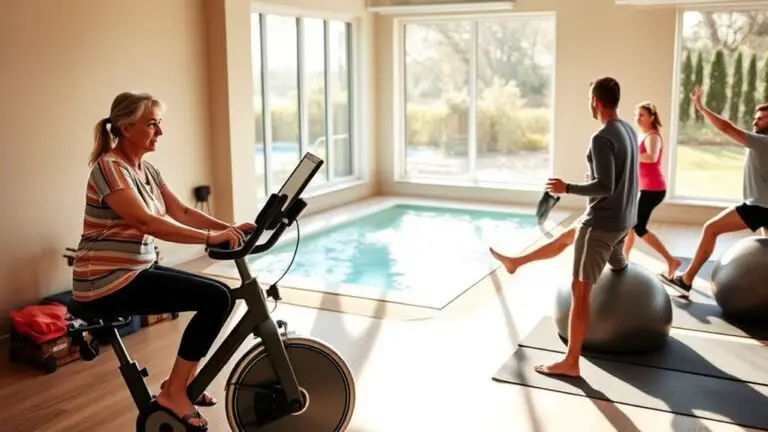How to Train for Endurance Like a Professional Cyclist

To train for endurance like a professional cyclist, focus on boosting your aerobic capacity and muscular endurance. Incorporate interval training sessions with a mix of short and long efforts, while maintaining proper nutrition through smart carb intake and hydration strategies. Prioritize recovery with active rest and quality sleep. Additionally, set achievable goals and track your progress to stay motivated. There’s much more to discover to refine your training even further.
Understanding Endurance and Its Importance in Cycling

Endurance isn’t just a buzzword in cycling; it’s the backbone of every successful ride. Understanding endurance involves recognizing two main components: aerobic capacity and muscular endurance. Aerobic capacity refers to your body’s ability to take in and utilize oxygen during prolonged activities. The higher your aerobic capacity, the longer you can ride without getting fatigued, which is vital for safety on longer journeys.
Muscular endurance, on the other hand, relates to how well your muscles can perform repetitive movements over time. Improved muscular endurance helps you maintain proper cycling form, reducing the risk of injury. By focusing on both aspects, you’ll not only enhance your performance but also guarantee your rides are safer and more enjoyable.
Implementing Interval Training for Maximum Gains
To boost your endurance training, incorporating interval training can make a significant difference. Interval workouts elevate your heart rate and improve your aerobic capacity while safely pushing your limits. Here’s how to get started:
Incorporate interval training into your routine to enhance endurance and elevate aerobic capacity effectively.
- Warm-Up: Always begin with a 10-15 minute warm-up in a low training zone to prepare your body.
- Choose Your Intervals: Select a mix of short (30 seconds) and longer (2-5 minutes) intervals at higher training zones, varying intensity.
- Recovery: Allow equal or slightly longer recovery periods between intervals to guarantee safety and effectiveness.
- Cool Down: End with a 10-minute cool-down, bringing your heart rate back down gradually.
The Role of Nutrition in Endurance Performance

While you might focus on training techniques, nutrition plays an essential role in enhancing endurance performance. To fuel your rides effectively, pay attention to carbohydrate timing. Consuming carbs before and during your rides can help maintain energy levels, allowing you to push harder and longer. Aim for easily digestible sources, like energy gels or bananas, to avoid stomach discomfort.
Hydration strategies are equally important. Dehydration can severely impact your performance, so drink water regularly before, during, and after your rides. Consider electrolyte drinks during longer sessions to replenish lost minerals, which can help prevent cramping and fatigue.
Recovery Strategies to Enhance Stamina
As you push your limits in endurance training, effective recovery strategies become essential for enhancing stamina and preventing burnout. Prioritizing recovery not only helps your body heal but also prepares you for your next workout. Here are four key strategies to contemplate:
- Active Recovery: Engage in low-intensity activities like walking or gentle cycling to promote blood flow without overwhelming your muscles.
- Sleep Optimization: Aim for 7-9 hours of quality sleep per night. Establish a bedtime routine to improve your sleep environment and enhance recovery.
- Hydration: Stay hydrated before, during, and after your workouts. Proper hydration aids in muscle repair and overall performance.
- Stretching and Foam Rolling: Incorporate dynamic stretching before workouts and foam rolling afterward to relieve muscle tightness and improve flexibility.
Setting Realistic Goals and Tracking Progress

Setting realistic goals and tracking your progress are essential steps in your endurance training journey, ensuring you stay motivated and on the right path. Start by using effective goal setting techniques, like the SMART method—setting Specific, Measurable, Achievable, Relevant, and Time-bound goals. This helps you establish clear targets that are both challenging and attainable.
Next, implement progress tracking methods to monitor your improvements safely. Keep a training log where you can note distances, times, and feelings after each ride. This not only helps you see your growth but also identifies areas needing attention. Regularly review your goals and adjust them as necessary, allowing flexibility in your training. Remember, it’s about gradual progress, not perfection. Celebrate small victories along the way to stay motivated and engaged in your endurance training, ultimately leading to a healthier and more enjoyable cycling experience.
Frequently Asked Questions
What Type of Bike Is Best for Endurance Training?
When you’re choosing a bike for endurance training, consider a road bike for its speed and efficiency on paved surfaces. A gravel bike offers versatility, allowing you to tackle rougher terrain safely. If comfort’s your priority, a hybrid bike blends characteristics of both road and mountain bikes, making it great for longer rides. For triathletes, a triathlon bike optimizes aerodynamics, but make certain it fits well to prevent strain. Each option has its benefits, so pick what suits you best!
How Often Should I Replace My Cycling Gear?
Just like a trusty steed needs care, your cycling gear has its own lifespan. You should replace items when you notice wear and tear—frayed straps, worn-out soles, or faded fabrics are clear replacement signs. Generally, helmets should be swapped every 3-5 years, while shoes and shorts might last a season or two depending on usage. Keeping your gear in top shape guarantees your safety and comfort on those long rides.
Can I Train for Endurance Without Cycling Daily?
Yes, you can train for endurance without cycling daily. Incorporating cross training benefits, like running or swimming, can enhance your cardiovascular fitness while reducing the risk of overuse injuries. Make certain to include recovery techniques, such as stretching or foam rolling, to help your muscles heal and regain strength. Balancing your training with rest days guarantees you stay safe and can improve your overall endurance without the need for daily rides.
What Mental Strategies Help During Long Rides?
Did you know that 80% of endurance athletes say mental strategies greatly boost their performance? During long rides, try visualization techniques to picture yourself overcoming challenges, which can enhance your focus. Additionally, use positive affirmations like “I’m strong” or “I can do this” to keep your spirits high. Remember, staying mentally sharp not only makes the ride more enjoyable but also helps you stay safe and aware of your surroundings.
How Do Weather Conditions Affect Endurance Training?
Weather conditions can greatly affect your endurance training. High temperatures can lead to dehydration and heat exhaustion, so it’s important to stay hydrated. Conversely, cold weather can impact your muscles, making warm-ups essential. Humidity’s impact shouldn’t be underestimated, as it can increase sweat loss and fatigue. Always dress appropriately for the conditions and listen to your body; adjusting your training schedule might be necessary for safety and ideal performance.





